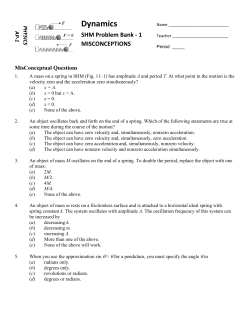
Forces: Oscillations
Hooke’s Law & Oscillations Physics 110 Laboratory Introduction: In this experiment we will investigate motion under the influence of a variable force. In particular, we first investigate the force that a spring exerts as it stretches more and more. We then study the oscillating motion that a hanging mass experiences once it is suspended from the spring. According to Hooke’s law the force that a spring exerts when it is stretched or compressed is directly proportional to the distance over which it is compressed/stretched, namely F = −ky , where k is called the spring or stiffness constant in N/m. Although this “law” is often an idealization for most elastic media, it is conceptually very useful. This is because understanding this law allows for a simple approximation of most forces that change as a function of position. So, by examining the motion under the influence of a spring that follows Hooke’s criteria we could get a broad understanding of most oscillating systems. Apparatus: The experimental arrangement that we use in this lab is very simple. It consists of a spring (conical brass), assortment of hanging masses, clamps, ruler, and a force sensor connected to our DataStudio setup. Procedure: Part I: Hooke’s law • Hang the spring vertically from a clamp with the large diameter coils down. Attach a 50g mass to the end of the spring. Draw a free body diagram in the space below and apply Newton’s second law of motion to derive an expression for the magnitude of the force exerted by the spring in terms of the weight of the attached mass. • Measure the distance that the spring stretches when the 50g mass is hung. Record your value in the table below. Repeat for the other masses listed and put the results in the table. Please take care not to hang too heavy a mass to cause a permanent deformation of your spring. m (kg) 0.050 0.100 0.150 0.200 0.250 0.300 0.350 0.400 y (m) Modified 4/14/15 • Enter your data into an Excel spreadsheet and calculate the magnitude of the force F exerted by the spring on each mass. Create a graph of the force F versus the stretch y . Title and label appropriately the axes of the plot. Does the spring appear to obey Hooke’s law? Explain in the space below. • Fit the data to determine an equation that describes the relationship between F and y and display the equation on the graph. Print a copy of your graph. Determine the spring constant from the fit to your graph. Use the linear regression tool in Excel to determine the uncertainty in the spring constant and record the spring constant and its uncertainty below. Part II: Oscillation of a mass on a vertical spring • Hang a 200g mass from the spring and place the motion sensor facing below the hanging mass making sure the motion sensor faces upwards. Open Data Studio. Pull the mass straight downward about and let go. Using Data Studio record the position of the mass as it oscillates on the end of the spring. Do not pull the mass so far that you have a large amplitude when released and try not to let the mass wildly oscillate. Record data for four or five cycles of the motion. Does the motion appear to be periodic? Is it sinusoidal? • Fit the data with a sine curve and determine the period T of this oscillation. Record your value in the table below. Repeat for the masses given in the table below. m (kg) 0.050 0.100 0.150 0.200 0.250 0.300 0.350 0.400 T (s) 2 • Enter the data into an Excel spreadsheet and create a graph of the period of oscillation T versus the mass m suspended from the spring. Does the graph appear to be linear? Should it be? • Fit the data with a power law and determine the equation that describes the data. Display the equation on the graph. Appropriately title and label the axes and then print a copy of this graph. How does the exponent of compare with the theoretical expression? Try to explain any discrepancies. • Next, make a plot of the square of the period of oscillation T 2 versus the mass m suspended from the spring. Does this graph appear to be linear? Should it be? If your data are linear, determine the spring constant of the spring and compare this with the one you obtained in part I. Use the linear regression k + kII tool to determine the uncertainty. Calculate a percent difference using % = I × 100 , where kI and kI +II ,avg k II are the spring constants you determined from part I and part II respectively and kI +II ,avg is the average of the two spring constant values from parts I and II. 3 • Fit the data and determine an equation that describes the data. Display the equation on the graph. Title and label the axes and print the graph. Does the y-intercept of your graph pass through the origin? Should it? If you have a non-zero y-intercept, what then, does it tell you about the oscillating massspring system? • Does any part of the mass of the spring mS contribute to the period of oscillation T ? If so, derive an expression for the fraction of the spring’s mass ( α ) that affects the period of oscillation T . Measure the mass of the spring mS and determine what fraction ( α ) of the spring’s mass affects the period of oscillation T ? Show your work and your calculations below. 4
© Copyright 2025











